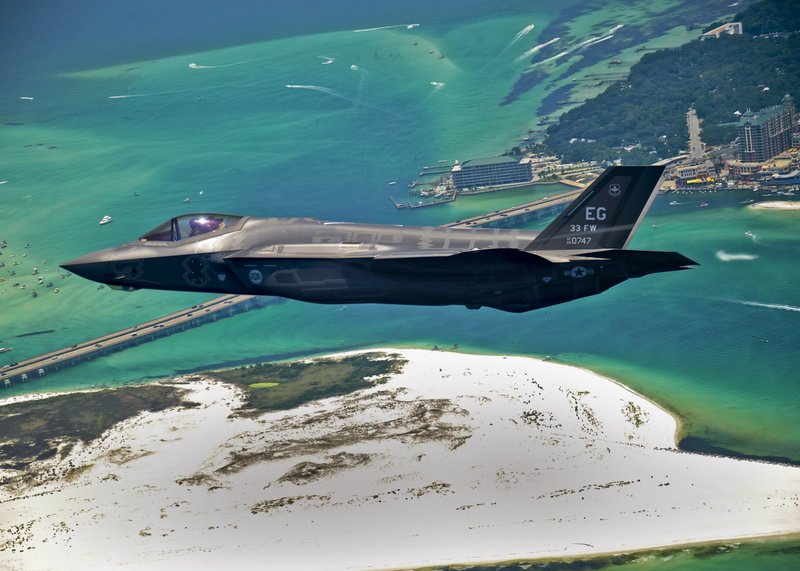How Chinese advancements will impact the future development of the US Air Force fleet
The B-21 Raider. (Photo: US Air Force)
Recent Chinese advancements in the air domain have been placing the US Air Force (USAF) in an uncomfortable position and the service will have to change its approach to developing, procuring and modernising aircraft, according to the head of the branch.
“China remains a problem [in the coming decades],” said USAF Secretary Frank Kendall. “Russia doesn’t go away as a serious threat, but China increasingly dominates the story [and] is a strategic competitor to the US.”
Speaking in a webinar conducted on 13 January led by the US-based think tank CSIS, Kendall pointed out that both the US Space Force and USAF “need to go through a transformation” until 2050.
Related Articles
US Air Force fires warning as China attempts to recruit US airmen
Should the US be concerned about the state of its nuclear arsenal?
China unveils new military kit and demonstrates technological prowess
Some possible lines of action to conduct the process were disclosed in a report, The Department of the Air Force in 2050, recently submitted by the branch to the US Congress.
The document foresees where the branch should be in 25 years’ time and the threats it might face in order to ensure military superiority in tomorrow’s air warfare.
From Kendall’s perspective, constrained budgets, along with a reluctance to retire obsolete platforms and embrace new technologies, “can have a negative impact” on the Air Force’s ability to be competitive with the People’s Liberation Army Air Force (PLAAF).
“We’re no longer an area where we can buy a platform, wait for it to wear out and don’t replace it,” Kendall remarked. “We have got to buy things to stay competitive over time, and that is going to be a fundamental change in how we resource and plan for the future.”
Such an approach to withstanding Beijing’s capabilities would impact current and future modernisation and procurement programmes, involving the acceleration of ongoing efforts, as well as the reassessment and modification of requirements for ongoing initiatives .
Future USAF fighter jets
In terms of fighters, China already has two models of fifth-generation jets in its inventory, the J-35A and the J-20. Moreover, in December, the PLAAF conducted flight tests with two stealth combat aircraft which appeared to be sixth-generation capabilities.
Meanwhile, the US has faced multiple challenges in advancing the procurement of the fifth-gen F-35 multirole fighter, including technical issues such as the inaccuracy of the weapon system, problems associated with the mission system radar hardware and software, and an excessive logistics footprint – especially for Marine Corps F-35B.
Other deficiencies in the effort have involved the failure to meet key availability and reliability requirements, as well as delays in promised improvements.

“We are now at the point where we commit to going forward, to finish design and go into production of that or not,” Kendall stated. “And this is really the most important milestone for almost any programme.”
The F-25 effort started in 1995, with the first system being delivered to the USAF in 2011. The branch, however, has not planned its replacement.
An unclear future for NGAD
The service has been also working on the Next Generation Air Dominance (NGAD), which is intended to provide the branch with a crewed sixth-gen family of systems centred around the unmanned collaborative combat aircraft (CCA).
Although the platform has been planned to replace the F-22 Raptor and could be an option to substitute the F-35 capability in the next decades, its future remains blurry.
The service paused its progress in August 2024 to assess costs and decide whether or not NGAD still met the challenges of the changing threat environment. The service then conducted a four-month analysis of the programme.
According to Kendall, the consensus “was largely that there is value in going ahead” with the programme, despite the service not awarding a contract for the NGAD platform in 2024 as it had initially planned. The future of the programme will now be defined by the incoming Trump administration.
“I really felt that the right thing to do was to let the next administration make this decision,” said Kendall. “They are going to live with it and they are going to execute it. Hopefully, we will get people in who can make wise judgments about this pretty quickly.”
Keeping up with Chinese nuclear capabilities
In the 2024 China Military Power Report issued by the US Department of Defense (DoD) in December, the Pentagon highlighted that Beijing “probably will continue to rapidly modernise, diversify and expand its nuclear forces” over the next decade.

In Kendall’s opinion, the US has “a serious competitor and we better start taking that seriously”.
In terms of nuclear-capable air systems, the PLAAF operates the H-6N bomber which is a version of the H-6 optimised for long-range strikes.
Entering service in 2020, the H-6N is fitted with an air-to-air refuelling probe and fuselage modifications that enable external carriage of a nuclear-capable air-launched ballistic missile (ALBM) and conduct nuclear precision strikes against targets in the Indo-Pacific.
The DoD report highlighted that, in addition to its current capabilities, China has been working on the development of another strategic stealth bomber.
The ground-based leg of the Chinese triad, concurrently, consists of intercontinental ballistic missiles (ICBM) with different basing modes and road-mobile systems. Its inventory has the CSS-4 (DF-5 class) liquid-propellant ICBMs and CSS-10 (DF-31class) solid-propellant ICBMs. The country has also been working on a new DF-5C silo-based, liquid-fueled missile.
“Additionally, China has conducted extensive renovations of several facilities at units fielding legacy DF-5-class ICBMs, which may indicate these units are likely to field more modern DF-5-class missiles,” the Pentagon’s report stated.
Kendall noted: “It is a different world when China, Russia and the US all have 1,000-plus nuclear weapons in the field. It gets more dangerous as there are other countries that proliferate weapons, as people think about and talk about using nuclear weapons as part of their escalation control.”
USAF nuclear capabilities
The US Air Force is responsible for the ground and air legs of the nuclear triad, which was designed and built in the Cold War era, and has been in service for more than five decades.

The Minuteman III (MMIII) ICBM system (the US ground-based nuclear leg) was first deployed in the 1960s. The service’s nuclear-capable fleet, in turn, currently includes B-1, B-2 and B-52 bombers.
The first B-1 was produced in the 1980s while initial deliveries of B-2s took place in 1993. The B-52 Stratofortress heavy bomber plane entered service between 1955 and 1962 and has been upgraded to remain in operation past 2040.
Although the branch has been working on the replacement of its nuclear arsenal, progressing with those efforts has been challenging, expensive and slow.
The Sentinel ICBM programme, the planned replacement for the MMIII, is at least two years delayed compared to its initial schedule and has exceeded its baseline cost projections.
The effort to update the ground-based leg of the nuclear triad is now estimated to cost US$140.9 billion which represents an 81% increase compared to its 2020 baseline cost estimates.
The programme has suffered a critical breach according to the definition within the Nunn-McCurdy Amendment to the Defence Authorisation Act. It forced the DoD to notify Congress about the additional costs and reassess its next stages. The branch now estimates that Minuteman IIIs will have been replaced by 2050.
In the case of the air leg, the B-21 Raider is planned to substitute the B-1 and B-2. Currently in low-rate initial production, this aircraft first flew in 2023 and is expected to enter service in the mid-2020s.
“Sentinel and B-21 are obviously going to continue, but I think we will have at some point to take a look at whether that is adequate, given the two hostile nuclear powers that we were most concerned about,” Kendall exclaimed.
Related Programmes in Defence Insight
Related Equipment in Defence Insight
More from Air Warfare
-
![What lessons could Europe learn from air power use in Ukraine?]()
What lessons could Europe learn from air power use in Ukraine?
The use of air power by both sides in the ongoing conflict has been extensively focused on, influencing policy and procurement around the world. But are the lessons from the front line universally applicable, or should other nations be planning for very different scenarios?
-
![Baykar completes Piaggio Aerospace takeover with plans to boost drone production]()
Baykar completes Piaggio Aerospace takeover with plans to boost drone production
The takeover of the Italian firm by Baykar solidifies the company’s efforts to forge closer ties with Italian industry, bolsters its partnership with Leonardo to produce UAVs and secures its foothold in Europe.
-
Leonardo’s Proteus structural tests “nearing completion” ahead of first flight
The company has tested over 15 mission sets for the drone, with the rotorcraft used to demonstrate the viability of armed forces utilising large uncrewed aerial systems’ (UAS) for autonomous missions in the future.






















